Fact: flies are the coolest insects.
If you don’t believe me, take a look at this newly described weevil, Timorus sarcophagoides Vanin & Guerra, from Brazil, which is doing everything it can to fool you into thinking it’s a flesh fly (family Sarcophagidae).
Still not convinced? How about seeing it in the wild, strutting its stuff like a sexy sarcophagid.
The bright red “eye”, the yellow striping on the “thorax”, the flatly toned “wings” with “venation” and the striped abdomen come together and scream I’M A FLY! Simply amazing.
The authors that found and described this species did a bang up job of recording its natural history as well. Observed feeding on and laying eggs into the flower buds of a woody mistletoe (Psittacanthus robustus) in the savannah of southeastern Brazil, the beetle even walks like a fly, performing “unusual jerking movements of the legs and a stereotypical leg scrubbing behavior mimicking the behavior of flesh-flies” (Vanin & Guerra, 2012). If the weevil finds itself under threat from an over-zealous entomologist, it gives up the illusion, tucks up its legs and rolls right off the branch, stem or leaf it was on, falling into the undergrowth and out of sight (a behaviour called thanatosis).
But, besides chronically poor self-esteem, why would a beetle evolve to look like a fly? If you’ve ever tried to catch a house fly with your bare hands, you’ve probably noticed flies are pretty quick and can disappear from sight in the blink of an eye. This agility means that birds very rarely feed on flies; ironically they only make up 15% of a tropical flycatchers insect diet, while swifts, swallows and foliage-gleaning vireos are even worse, with less than 6% of their insect diet being of the two-winged variety (Hespenheide, 1973). Of the consumed flies, most are the slower, more cumbersome nematocerans like mosquitoes, midges and gnats, while the larger, faster Brachycera (house flies, horse flies, blow flies, the vast majority of fly diversity) very rarely become dinner.
And this is why it’s advantageous to look like a fly. If a bird continually wastes its energy chasing after flies without ever catching them, it will eventually stop trying to and instead save its energy to go after slower-flying insects like wasps and beetles. By looking like a fast-moving fly rather than a slow-moving beetle, these weevils are signalling to their potential avian predators “You know you can’t catch me, don’t even bother. Go eat something your own speed!”, while taking their time to enjoy a nice leisurely meal.
So the next time you’re walking down Sesame Street at night and fear Big Bird may be following you with evil intentions, pretend you’re a fly; not only will it save your life, but you’ll look cool while you’re at it!
UPDATE: One of the authors that described this new beetle, Tadeu Guerra, contacted me and shared a few other photos that didn’t make it into the publication. He’s given me permission to post them here, and they do a great job of showing just how good a mimic this beetle really is!
———————–
HESPENHEIDE, H.A. (1973). A novel mimicry complex: beetles and flies, Journal of Entomology Series A, General Entomology, 48 (1) 55. DOI: 10.1111/j.1365-3032.1973.tb00034.x
Vanin, S.A., & Guerra, T.J. (2012). A remarkable new species of flesh-fly mimicking weevil (Coleoptera: Curculionidae: Conoderinae) from Southeastern Brazil Zootaxa, 3413, 55-63PDF Available Here

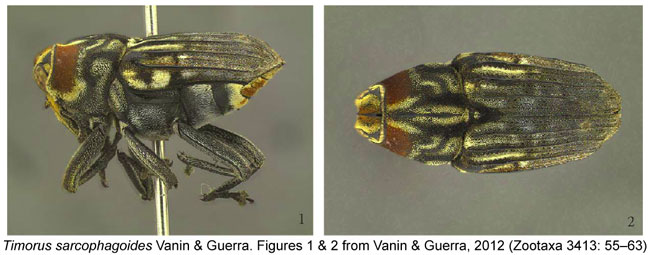
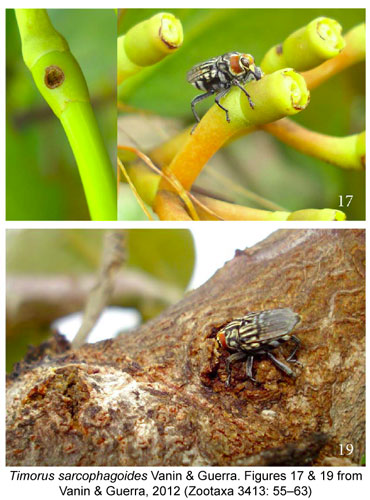
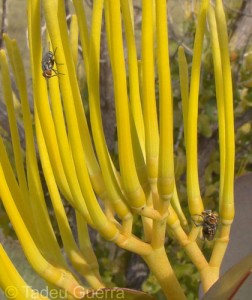
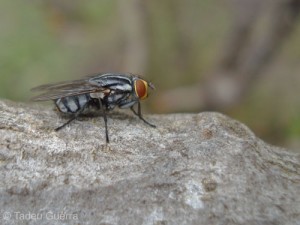
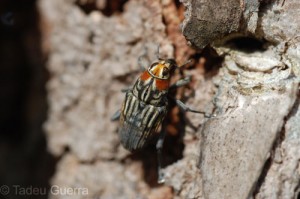
Hespenheide (2012) also recently described several buprestid beetles in the über-diverse genus Agrilus. While they exhibit reddish head and/or pronotum with bluish coloration behind, they are nearly as strikingly close to the model as this weevil is!
Hmm, not sure I’m buying the Diptera connection with those Agrilus, but I might have to read more into this mimicry complex as it seems pretty relevant to my micropezid work! Thanks for sharing that Ted.
p.s. does anyone interact through blog comments anymore, or has everything just moved to tweets and retweets?
If I’m contributing something or asking a question directly related to the post, I try and do it in the comments to keep ideas concentrated in one location. Plus the back and forth is fun! I use Twitter for promotion of articles & blogs and try to make jokes/puns associated with them (much like my Weekly Flypaper comments).
I use Twitter for promotion of articles & blogs and try to make jokes/puns associated with them (much like my Weekly Flypaper comments).
Just a short interaction: another great post. Never knew that weevils mimicked flies. Or that flies were such a small part of a bird’s diet. A lot of info here, well written on top ot it! Thanks.
I didn’t known about the beetles or the bird diets before I read this paper and started learning more to write this up either! That’s one of the main reasons why I keep this blog, to share these mini-discoveries I stumble across so others can experience the same feeling of discovery and amazement that I do when I learn some new natural history factoid. Thanks for reading, and I’m glad you enjoyed it!
Geez…that thing really does look like a lot like a Sarc in the live shots. Hard to believe it’s evolved with such specific patterning. It looks more like someone picked it up and painted on it!
Flesh fly painted weevils. What will natural selection come up with next?
That’s amazing. The habitat shots are pretty convincing. I’ve seen some oddly colored/patterned weevils before, and now I’ll be paying more attention.
Ha! Even some of the beetles themselves understand that flies are cooler.
There are several things to see on my wishlist, including a genuine alien spacecraft, and this. I got to strike this one – thanks to you!
But, wouldn’t the slow moving beetles greatly increase the birds’ success rates in eating ‘flies?’
Wouldn’t that then end up with more ‘fly’ look a likes in their diet?
Ghost.
Hi Ghost,
The trick with mimicry systems like this is they only work if a few organisms try it. It’s kind of like the proverbial “Needle in a haystack”; there are so many more real flies around for birds to fail to catch that there is a very low chance of a bird catching a “fly imposter” before deciding not to try in the first place. As long as beetle populations aren’t high enough to significantly change the ratio of fakers to flies, they should be able to get away with it.
Fact: beetles are the coolest insects…as clearly demonstrated by this absolutely amazing beetle!
Seriously, this is one of the neatest things I’ve seen/read in quite a while. Those shots of the weevil in the wild are almost unbelievable. Any idea if other species in the same genus are also mimics?
Hi Traci,
this genus has other seven species described, all from south america (5 from Brazil and 2 from French Guyana), but just this new species is flesh-fly mimic. In effect, this mimicry system is also, probably, an exemple of convergent evolution, because this coloration pattern can be found in beetles from different families and genera. Please see: Hespenheide, H.A. (1973) A novel mimicry complex: beetles and flies. Journal of Entomology (A), 48, 49–56. and Hespenheide, H.A. (1995) Mimicry in the Zygopinae (Coleoptera, Curculionidae). Memoirs of Entomological Society of Washington, 14,145–154.
Hi Tadeu,
Thanks for this great information! I’ll definitely check out that article!
thanks.
Nice post!